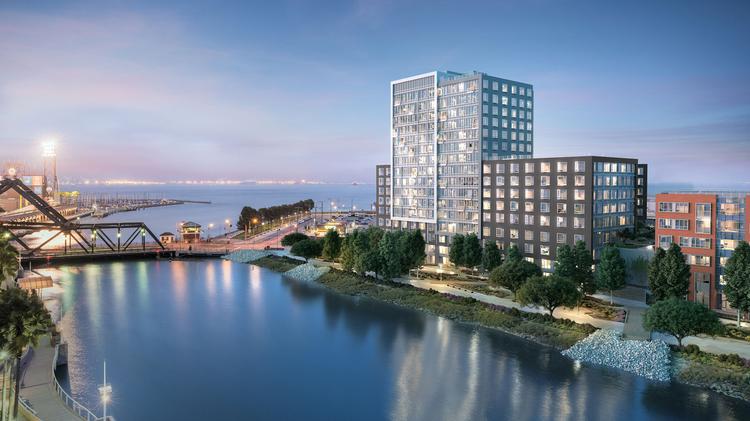
Community begins to take shape in Mission Bay as affordable and luxury units near completion
Sixteen years after developers started building housing in Mission Bay, the neighborhood is becoming a mixed-income community as market-rate and affordable projects sprout up on the former industrial site.
Dominated by biotech R&D buildings and UCSF’s medical and research facilities, Mission Bay needs housing to balance out its commercial growth. By this summer, 5,446 of the neighborhood’s 6,404 residential units will have been completed, a process which began nearly two decades before. That’s when the neighborhood became a redevelopment area, according to the Office of Community Investment and Infrastructure (OCII), the city agency tasked with overseeing Mission Bay’s development.
By the end of 2017, one market-rate project, One Mission Bay, and one affordable project, Five 88, will be completed, reflecting the economic diversity envisioned by city officials. Another market rate project, Eviva Mission Bay, has finished and is ready for tenants. When officials agreed to make Mission Bay into a redevelopment area, they required that, when complete, 28 percent of all housing in the area would be for moderate, low and very low-income households.
“The mixed-income housing developed to date has created a vibrant community,” said Nadia Sesay, interim executive director of OCII.
Eviva Mission Bay and One Mission Bay add 479 housing units this year as the neighborhood’s last two market-rate projects. Eight affordable housing projects remain to be built.
While more than 6,400 units seems like a lot, Mission Bay’s employee base just keeps growing. UCSF, for example, plans to break ground this summer on a 340,000-square-foot academic tower, and Uber Technologies is under construction on its 435,000-square-foot office project.
That’s why the housing that has opened in Mission Bay has generally done well for developers.
One Mission Bay offers 350 luxury condominiums and is scheduled to open this summer.
“Demand for new construction product in San Francisco is always strong, and Mission Bay’s access to outdoor activity and major freeways has been a huge draw for the buyers,” Curtis Tischler, co-founder of Level Four Advisors, the firm handling sales and marketing for One Mission Bay, told the Business Times in June.
Amenities in Mission Bay still have a ways to go. While it finally has several parks open and the T-Third line makes commuting easier than it was years ago, the neighborhood still struggles with attracting enough retail for residents. The Market Hall, a small upscale grocery with an emphasis on prepared foods, at base of the Channel Mission Bay apartment development at Fourth and Channel streets finally opened last year, after numerous delays.
With a newly opened playground, Mission Bay has also become more family friendly for residents.
That’s good news for Related California and Chinatown Community Development Center, nonprofits that are opening Five 88, 200 units of affordable family apartments, within two months, according to Related California CEO Bill Witte.
The addition of more affordable developments is likely to result in still more children in Mission Bay, after years in which the neighborhood attracted more of a “younger and up-and-coming population,” Witte said.
After Five 88, the 143-unit rental complex at 626 Mission Bay Boulevard North — in which 20 percent of units are to be reserved for formerly homeless families — is next on the schedule, set for completion in late 2018.
Don Falk, CEO of Tenderloin Neighborhood Development Corp., which is developing 626 Mission Bay, said that the addition of more affordable housing in the area can help drive the creation of other services in the area.
“There’s a potential for the whole to be greater than the sum of the parts,” he said. “As nonprofits develop additional family housing, there’s going to be an additional impact that goes beyond the number of units in the building itself.”
Meanwhile, UCSF tries to ensure it continues to have enough housing for students.
The school plans to build affordable student housing for as many as 810 people. The project could open as soon as 2019 on Minnesota Street, according to Christine Gasparac, director of community relations at UCSF.
“We have a desperate need for affordable student housing,” Gasparac said. “It’s tough for UCSF to attract top students when they look at the rental market numbers.”
Need to know
958: Number of residential units remaining to be built in Mission Bay after this summer
810: Number of students that would be accommodated by UCSF’s new project
20170223
